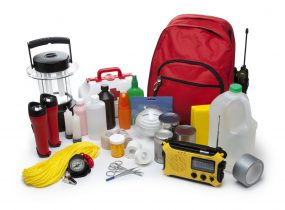Essential Emergency Preparedness: Your Comprehensive Guide
Essential Emergency Preparedness: Your Comprehensive Guide
Blog Article
Just How to Create a Comprehensive Emergency Preparedness Plan
In the realm of preparedness, establishing an extensive emergency situation plan is not merely a task to examine off a listing; it is a crucial foundation of any company or person's resilience strategy. By diligently crafting a strategy that resolves numerous elements of emergency situation administration, consisting of risk evaluation, interaction methods, source allowance, and strategic decision-making, one can lay a solid structure for securing properties, operations, and lives.
Significance of Emergency Situation Preparedness
Emergency preparedness is vital for mitigating prospective dangers and ensuring the safety of individuals and communities. In today's globe, where all-natural disasters, public wellness dilemmas, and various other emergencies can strike without caution, being prepared can make a substantial difference in minimizing the influence of these occasions. By having a well-balanced emergency preparedness plan in position, organizations and people can react efficiently, shield lives, and decrease residential or commercial property damages.
Among the primary reasons that emergency situation preparedness is necessary is its duty in conserving lives. Having a strategy that details clear treatments for interaction, emergency, and emptying reaction can help individuals act quickly and decisively when emergency situations happen (read the full info here). This can avoid injuries and deaths by making sure that people recognize what steps to require to stay secure
Moreover, emergency situation preparedness improves the strength of neighborhoods. By cultivating a society of preparedness and preparation for various situations, communities can bounce back faster from interruptions and catastrophes. This resilience is necessary for maintaining stability, continuity of operations, and total health when faced with difficulty.
Assessing Possible Dangers
Taking into consideration the relevance of being planned for unforeseen events, the initial step in creating an effective emergency readiness plan entails extensively reviewing and evaluating possible dangers. This assessment needs a comprehensive evaluation of all feasible threats that could influence the organization, taking into consideration elements such as location, sector, and historic information on cases. By recognizing these risks, companies can prioritize their preparedness initiatives and assign resources successfully to mitigate the most considerable hazards.
Typical dangers that companies may encounter consist of all-natural disasters like earthquakes, floods, or typhoons, technological dangers such as power outages or information breaches, along with human-caused threats like mishaps or willful acts of physical violence. Performing a danger assessment likewise involves thinking about the prospective influence of these events on the company's procedures, staff members, clients, and credibility. By performing a detailed danger evaluation, organizations can establish customized emergency response plans that resolve their specific vulnerabilities and make sure efficient preparedness for any type of potential crisis.
Producing an Interaction Strategy
Establishing a detailed and clear communication strategy is important for effective emergency readiness within companies. In times of crisis, communication plays an essential function in making certain the safety and security and health of staff members, stakeholders, and the area. A well-thought-out communication plan need to lay out clear lines of communication, designate crucial personnel in charge of interaction tasks, and establish methods for distributing info quickly and precisely.
One key aspect of creating a communication strategy is determining key and alternative communication networks (EMERGENCY PREPAREDNESS). These can include email, message messaging, phone trees, social media systems, and public address systems. It is crucial to ensure that these channels are dependable, available, and frequently examined to guarantee their effectiveness during emergency situations

Structure an Emergency Situation Kit
Offered the crucial significance of readiness in times of crisis, a key element that organizations should resolve is the establishment of an emergency situation set. When assembling an emergency situation kit, it is necessary to think about the details needs and conditions of the organization. In addition, companies must consist of crucial records, such as get in touch with checklists, insurance policy information, and emergency reaction strategies, in waterproof containers within the kit.
Establishing Emptying Treatments
To make certain the safety and security and organized emptying of workers during emergencies, organizations need to develop reliable and clear discharge procedures. Emptying procedures should incorporate a variety of potential circumstances, consisting of fires, all-natural disasters, or various other emergency situations that need speedy emptying.

In addition, companies ought to develop a system for accounting for all personnel throughout an evacuation to ensure that everyone has actually securely exited the facilities. Communication plays an essential role in emptying procedures, with clear instructions on just how to leave and when to do so. Normal review and upgrading of evacuation treatments based on responses and transforming conditions are necessary to preserving the effectiveness of the plan.
Conclusion
In conclusion, developing a thorough emergency preparedness plan is essential for ensuring the safety and security and health of individuals in case of a calamity (EMERGENCY PREPAREDNESS). By examining potential risks, developing a communication plan, constructing an emergency situation package, and developing discharge treatments, companies and people can be better geared up to react efficiently to emergencies. It is necessary to focus on readiness a fantastic read efforts to minimize the effect of catastrophes and shield lives and residential or commercial property
In the world of readiness, developing a comprehensive emergency plan is not just a job to check off a checklist; it is an essential keystone of any type of organization or person's resilience approach. When emergency situations occur, having a strategy that describes clear treatments for evacuation, emergency situation, and communication feedback can help individuals act swiftly and emphatically. check my blog. By performing a detailed danger assessment, organizations can establish customized emergency response plans that address their particular vulnerabilities and guarantee efficient preparedness for any type of prospective dilemma
Creating a comprehensive and clear interaction strategy is essential for effective emergency readiness within companies. By analyzing possible threats, developing an interaction strategy, developing an emergency kit, and developing discharge individuals, companies and treatments can be better furnished to respond properly to emergencies.
Report this page